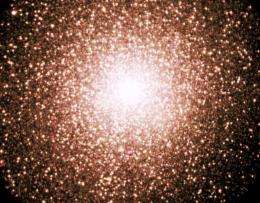An optical image of the globular cluster, 47 Tucanae. Astronomers have studied the many stars in this cluster to learn more about how dust is produced in the winds of its older stars. Credit: South African Astronomical Observatory
(PhysOrg.com) -- Interstellar space contains vast quantities of dust that obscures our view while helping to catalyze the chemical reactions that turn atomic gases into complex molecular species. Most dust is made in the winds of older stars (called asymptotic giant branch, "AGB," stars) that have completed the hydrogen burning phase of their lives. The sun is still in its "main-sequence" stage of life. Astronomers think that the process of dust manufacturing is quite general, and is also responsible for dust seen in the early universe. Although dust production is important, exactly how it is made remains a mystery.
A number of factors complicate the research effort. It is difficult to measure adequately the winds that generate dust in many faint stars. It is hard to determine the grain properties like size, density, shape, or composition. Not least, no one knows how dust production varies among AGB stars of different masses or evolutionary stages, or the precise role of radiation pressure in driving the winds.
To help sort out these and other issues, CfA astronomers Joe Hora and Tom Robitaille joined with thirteen colleagues to examine closely the globular cluster 47 Tucanae, a massive collection of millions of stars in our galaxy that has the research advantage that all its stars formed at about the same time, and all are at about the same distance from us.
The team used observations of the cluster's stars across the spectrum from the visible wavelengths through the infrared, and in particular they relied on infrared observations from the Spitzer Space Telescope. They modeled statistically the emission of the stars to establish their range of physical parameters (mass, for example), and to model the evolution of the system. Writing in the new issue of the Astrophysical Journal, they report that the distance to the cluster is 15,040 light-years with an uncertainty of about 4%, and it has an age of 12 billion years with an uncertainty of 8%. As for dust, they report that nearly all stars brighter than about 2000 solar luminosities are dust factories; most stars with half this luminosity or less do not produce dust. The result resolves a earlier debate about the dust production in fainter stars, and helps to pin down the masses and characters of the stars primarily responsible for making dust that blows in their winds.
Provided by Harvard-Smithsonian Center for Astrophysics
























